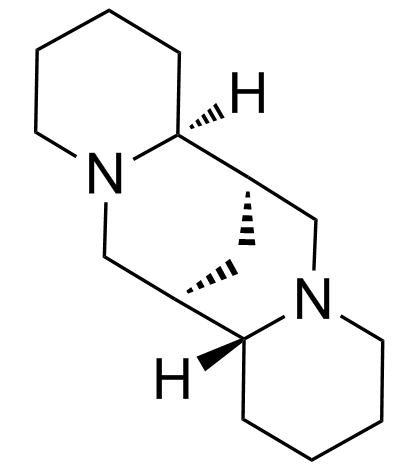492-08-0
| Name | (+)-Sparteine |
|---|---|
| Synonyms |
[7S-(7a,7aa,14a,14ab)]-Dodecahydro-7,14-methano-2H,6H-dipyrido[1,2-a:1',2'-e][1,5]diazocine
[7S-(7α,7aα,14α,14aβ)]-Dodecahydro-7,14-methano-2H,6H-dipyrido[1,2-a:1',2'-e][1,5]diazocine (1S,2R,9S,10S)-7,15-Diazatetracyclo[7.7.1.0.0]heptadecane Sparteine, (+)-Isomer lupinidine sparteine Pachycarpine (7α,9α)-Sparteine 7,14-Methano-2H,6H-dipyrido[1,2-a:1',2'-e][1,5]diazocine, dodecahydro-, (7R,7aR,14R,14aS)- 7,14-Methano-2H,6H-dipyrido[1,2-a:1',2'-e][1,5]diazocine, dodecahydro-, (7S,7aR,14S,14aS)- |
| Description | (+)-Sparteine is a natural alkaloid acting as a ganglionic blocking agent. (+)-Sparteine competitively blocks nicotinic ACh receptor in the neurons. |
|---|---|
| Related Catalog | |
| Target |
AChR[1] |
| In Vitro | (+)-Sparteine (2 μM) reduces the ACh-induced current caused by activation of nicotinic AChRs in a voltage-independent manner. (+)-Sparteine (5, 10 μM) reduces the amplitude of the excitatory postsynaptic current (EPSC) and the time constant of the EPSC decay[1]. |
| References |
| Density | 1.1±0.1 g/cm3 |
|---|---|
| Boiling Point | 340.9±10.0 °C at 760 mmHg |
| Melting Point | 201ºC |
| Molecular Formula | C15H26N2 |
| Molecular Weight | 234.380 |
| Flash Point | 148.3±6.8 °C |
| Exact Mass | 234.209595 |
| PSA | 6.48000 |
| LogP | 3.21 |
| Vapour Pressure | 0.0±0.7 mmHg at 25°C |
| Index of Refraction | 1.570 |
CHEMICAL IDENTIFICATION
HEALTH HAZARD DATAACUTE TOXICITY DATA
|
| Hazard Codes | Xi |
|---|---|
| RTECS | RT0620000 |

